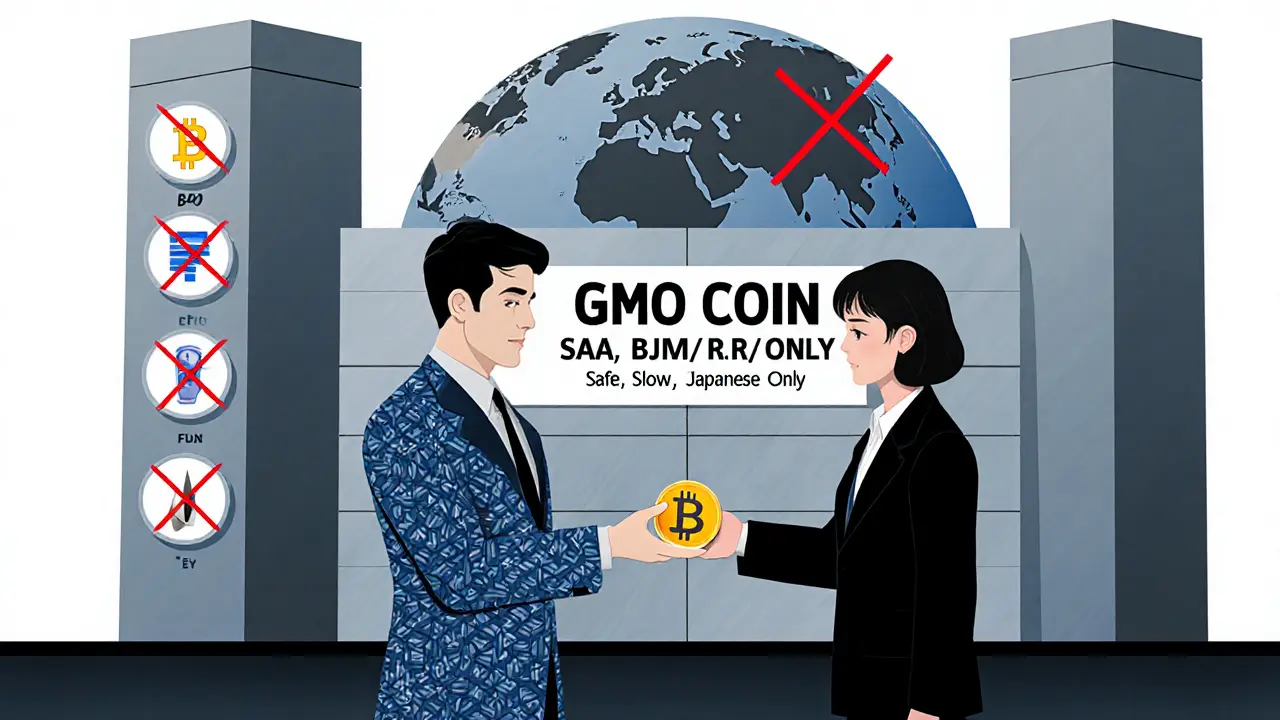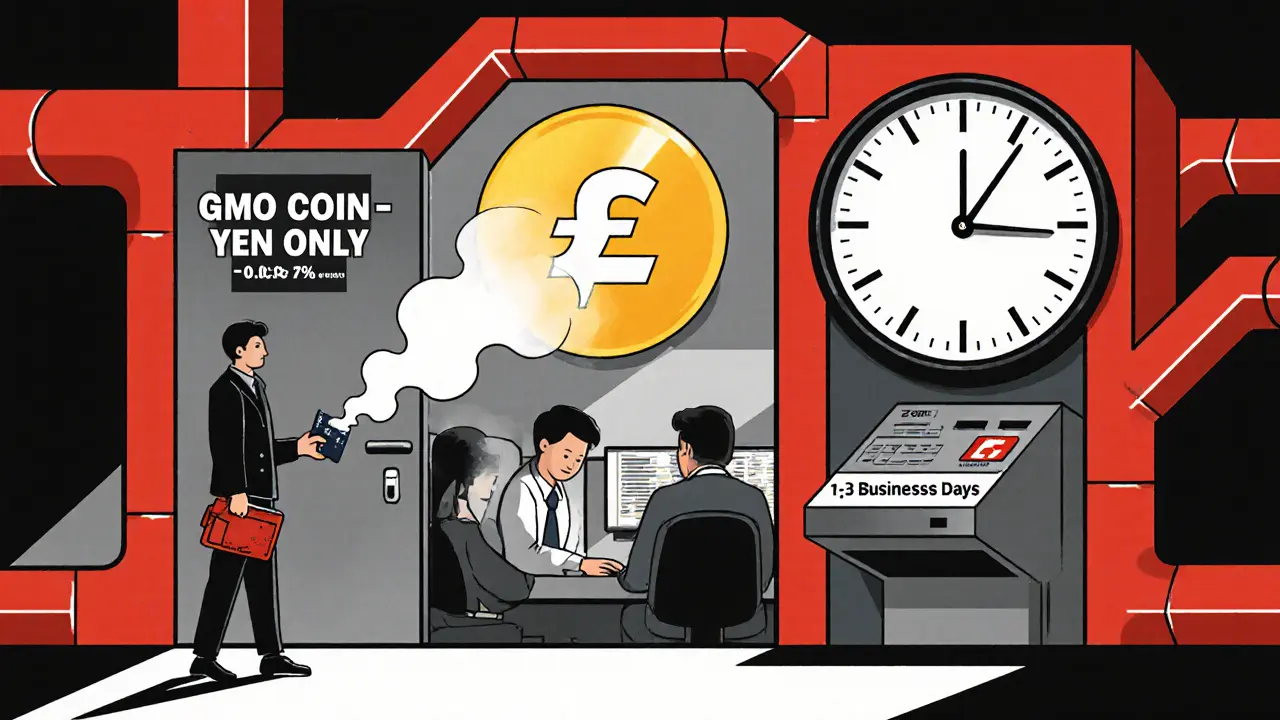GMO Coin Crypto Exchange Review: Is It Right for You in 2025?
 May, 26 2025
May, 26 2025
GMO Coin Fee Calculator
What Is GMO Coin?
GMO Coin is a cryptocurrency exchange launched in 2016 by GMO Internet Group, a publicly traded Japanese company on the Tokyo Stock Exchange (ticker: 9449). Unlike global platforms like Binance or Coinbase, GMO Coin operates almost entirely within Japan’s strict financial regulations. It’s regulated by Japan’s Financial Services Agency (FSA), which gives it legitimacy for Japanese residents-but not for most international users.
It’s not a flashy platform. There are no flashy memes, no influencer endorsements, and no credit card deposits. Instead, GMO Coin feels like a bank that decided to dabble in crypto. You won’t find hundreds of altcoins. You won’t get instant withdrawals. But if you live in Japan and want a safe, regulated way to buy Bitcoin or Ethereum with yen, it’s one of the few options you can trust.
Trading Pairs and Market Offerings
As of 2025, GMO Coin supports only five cryptocurrency trading pairs: BTC/JPY, ETH/JPY, XRP/JPY, LTC/JPY, and BCH/JPY. That’s it. No Solana, no Cardano, no Dogecoin, no meme coins. If you’re looking to trade lesser-known tokens, this exchange won’t help you.
This limitation isn’t a bug-it’s a feature. Japan’s regulators don’t allow exchanges to list risky or unvetted tokens. GMO Coin follows the rules. That’s why it’s trusted by Japanese retail investors who prioritize safety over speculation. But if you’re an international trader used to choosing from 500+ coins, you’ll feel like you’re stuck in 2015.
Fees: The One Thing GMO Coin Does Better Than Everyone Else
Here’s where GMO Coin stands out: fees. Most exchanges charge takers 0.10% and makers 0.025%. GMO Coin flips that. Takers pay 0.05%-half the industry average. Makers? They get paid. For every trade that adds liquidity, you earn -0.01%. That means if you place a limit order that gets filled later, the exchange gives you 0.01% of the trade value as a reward.
That’s rare. Only a handful of exchanges globally offer negative maker fees. It’s a smart move to attract institutional traders and high-volume users. If you’re placing lots of limit orders, you’ll literally get paid to trade. No other major Japanese exchange does this.
Withdrawals? Zero fees. You only pay the blockchain network fee-like any other exchange. No hidden charges for sending BTC or ETH out. That’s a big plus compared to platforms like BitFlyer, which charge withdrawal fees on some coins.
Deposits and Withdrawals: Wire-Only, No Credit Cards
Here’s the catch: you can only deposit Japanese yen via bank transfer. No credit cards. No PayPal. No Apple Pay. No crypto deposits from other wallets. You need a Japanese bank account. If you’re outside Japan, you’re locked out.
Withdrawals work the same way. You send yen back to your Japanese bank. Crypto withdrawals go directly to your external wallet. Processing times for yen transfers can take 1-3 business days. Crypto withdrawals usually clear within 2-4 hours, unless there’s network congestion.
This model is outdated for global users, but it’s intentional. GMO Coin avoids the fraud risks that come with card-based on-ramps. It’s safer-but far less convenient.

Security: Cold Storage, 2FA, and No Public Audits
GMO Coin stores 95% of customer assets in cold storage. That’s standard for regulated exchanges. Two-factor authentication (2FA) is mandatory. They use SMS and authenticator apps like Google Authenticator.
But here’s the problem: no public third-party audit reports. You can’t verify their reserves. Unlike Kraken or Coinbase, which regularly publish proof-of-reserves, GMO Coin doesn’t. That’s a red flag for international users who want transparency.
Still, their parent company, GMO Internet Group, is a billion-dollar public firm. They’re not going to risk their reputation on a crypto scam. For Japanese users, that’s enough. For others? It’s a gamble.
User Experience: Clunky for Non-Japanese Speakers
The website and app are functional, but they’re built for Japanese speakers. Only 35% of the help center is translated into English. Customer support emails respond in 48 hours. Phone support? Only in Japanese. Live chat runs 8 AM to 6 PM Japan time.
International users report confusion during KYC. The process takes 5-7 business days-double the global average. Trustpilot reviews from non-Japanese users average 2.3 out of 5 stars. Complaints include: “I couldn’t figure out how to deposit,” “No one answered my email,” and “The interface feels like it’s from 2018.”
Japanese users, however, rate the platform 82% for security and stability. During the 2024 Bitcoin crash, GMO Coin stayed online when smaller exchanges froze. That reliability matters.
Regulatory Status: Trusted in Japan, Risky Everywhere Else
GMO Coin is licensed by Japan’s FSA. That’s a strong credential. But outside Japan? Zero regulation. No MiCA license in Europe. No BitLicense in New York. No SEC oversight. If you’re in the U.S., EU, Canada, or Australia, you’re using an unregulated platform.
In March 2025, the FSA issued a business improvement order to GMO Coin over AML compliance gaps. That’s not a shutdown-it’s a warning. They’re being monitored. But it’s still a sign they’re not perfect.
Compare that to Kraken, which is regulated in 48 U.S. states and the EU. Or Bitstamp, licensed in New York and Luxembourg. GMO Coin doesn’t even try to compete globally. It’s a domestic player with global ambitions it’s not ready to fulfill.

Staking and Lending: New Features, Unclear Returns
In 2025, GMO Coin added staking for three proof-of-stake coins: ETH, ADA, and DOT. They also launched a lending program where users can earn “rental fees” by lending their crypto. But here’s the problem: they don’t disclose APY rates.
Other exchanges like Coinbase and Kraken show exact percentages. GMO Coin just says “earn based on volume.” That’s vague. It feels like they’re testing the waters without committing to transparency.
For Japanese users who trust the brand, this is enough. For everyone else? It’s a mystery.
Who Is GMO Coin For?
If you live in Japan: Yes. It’s one of the safest, lowest-fee ways to buy Bitcoin and Ethereum. The negative maker fee is a game-changer for active traders. The FSA oversight gives you legal recourse if something goes wrong.
If you’re outside Japan: No. You can’t deposit fiat. You can’t get help in your language. You’re not protected by any international regulator. The platform isn’t designed for you. Even if you find a way to fund it (like using a Japanese friend’s account), you’re taking on unnecessary risk.
If you’re an advanced trader: Skip it. Five trading pairs isn’t enough. No API. No margin trading. No derivatives. You’re stuck with basic spot trading.
If you’re a beginner looking for simplicity: Only if you’re in Japan. Elsewhere, Coinbase or Kraken are easier, faster, and safer.
The Bottom Line
GMO Coin isn’t trying to be the next Binance. It’s trying to be the most trustworthy crypto exchange in Japan. And in that narrow goal, it mostly succeeds.
Its fees are the best in the country. Its security is solid. Its regulation is real. But its global reach? Nonexistent. Its customer support? Poor for non-Japanese speakers. Its product range? Tiny.
If you’re a Japanese resident looking for a no-nonsense, low-fee, FSA-approved crypto exchange, GMO Coin is a top choice. If you’re anywhere else? Keep looking. There are better options out there that won’t leave you stranded in a language barrier with no customer support.
What’s Next for GMO Coin?
Leaked documents from mid-2025 suggest GMO Coin plans to expand its trading pairs from 5 to 15 by the end of 2025 and seek licenses in Singapore, Thailand, and Indonesia. But given their regulatory hiccup in March 2025 and their slow response to international demand, it’s unclear if they’ll follow through.
For now, GMO Coin remains a Japanese institution with global potential-but no global execution.
Jean Manel
October 30, 2025 AT 05:52William P. Barrett
October 31, 2025 AT 02:56Cory Munoz
October 31, 2025 AT 16:16Jasmine Neo
November 1, 2025 AT 22:04Ron Murphy
November 2, 2025 AT 12:05Prateek Kumar Mondal
November 2, 2025 AT 18:52Nick Cooney
November 3, 2025 AT 20:53Clarice Coelho Marlière Arruda
November 4, 2025 AT 20:35Brian Collett
November 5, 2025 AT 19:23Allison Andrews
November 6, 2025 AT 14:08Wayne Overton
November 8, 2025 AT 05:43Alisa Rosner
November 10, 2025 AT 04:02MICHELLE SANTOYO
November 10, 2025 AT 23:01Lena Novikova
November 12, 2025 AT 09:54Olav Hans-Ols
November 12, 2025 AT 15:37Kevin Johnston
November 14, 2025 AT 11:28Dr. Monica Ellis-Blied
November 15, 2025 AT 16:05Herbert Ruiz
November 17, 2025 AT 02:40